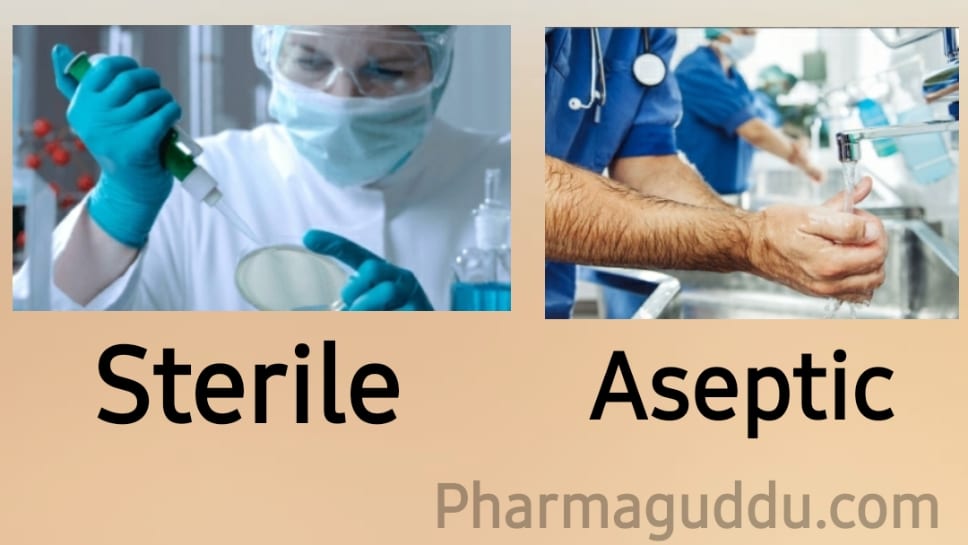Terms aseptic and sterile are significant concerns, and sometimes it is not easy to understand the differences between the two terms. For example, in the case of environment classification, some people might say the “sterile area”, and others use the term “Aseptic area”.
USP General information chapter no. 1116 describes the terms Aseptic and Sterile are not synonymous. It is a broad concept, and the US FDA does not include it in the guidelines.

Difference between Aseptic and Sterile Area
Sterile area:
Sterile means having an entire absence of viable microorganisms or organisms that have the potential to reproduce. No life at all like (bacteria, fungi, and viruses)
Sterile is basically, the surface and product contact part that is free from microbial contamination. The products that are free from all pathogens and microorganisms are called sterile products, such as surgical gloves (sterile surgical gloves), small-volume parenteral, and large-volume parenteral and ophthalmic products.
The technique used for the removal of all harmful microorganisms or pathogens is called the sterile technique.
What is Sterile Technique?
Sterile technique is a critical skill that is used in numerous fields such as microbiology, molecular biology, and cell biology. Before beginning any experiment make sure that you are wearing the appropriate personal protective equipment, including a lab coat, gloves, and, if necessary, safety glasses.
The best sterile technique is to follow the procedure (SOP), entry-exit procedure, handling of equipment, gowning procedure, and sanitization process.
Steps to Follow for Sterile Technique:
Body flora can often contaminate reagents. To lower the chance of contaminating your samples with body flora, make sure to wear a lab coat with cuffed sleeves or use disposable arm cuffs, covering your arms and wrists. Gloves are designed to shield you from the materials, but they also prevent the materials from getting contaminated by you. Keep your gloves clean by not touching your skin, hair, cell phone, writing tools, or any unsterilized objects.
Before you begin a new task, make sure to change your gloves if you touch something not clean. Remove any unnecessary things from your workspace. Arrange all materials so that they are easy to reach, and keep clean and dirty items clearly separated.
Work from left to right. Keep clean items on the left and waste bins on the right. If you use a Bunsen burner or candle jar, make sure there are no loose papers or lab wipes around. Wipe the workspace and pipettes with 70% alcohol and let them dry.
Before beginning a task, examine all of your materials for signs of contamination or signs that the sterility may have been compromised. Check all autoclaved items to ensure that the indicator tape has changed colors. For items that are covered with foil check for tears or holes for capped items, and ensure that the cap has been tightly sealed.
When working with agar dishes, inspect them for signs of microbial growth. Foil is frequently utilized as a cover for bottles and beakers. Before starting your work, Gently loosen the edges of the foil to make it easier to remove. When you are ready, gently lift the foil with one hand and keep it upright to prevent contamination of the sterile side.
Metal objects like forceps and spreaders are frequently used and reused in the lab. While these items can undergo sterilization in an autoclave, it is often more convenient to disinfect them with alcohol and a burner. To sterilize, dip the portion of the instrument intended for the procedure into 70% alcohol.
Aseptic area:
Aseptic means an area free of pathogens or microorganisms. The limits of microorganisms are not present there. An aseptic process prevents contamination by excluding microorganisms.
Aseptic technique:
The aseptic technique is a type of practice used to reduce the number of microorganisms and other life forms to maintain a sterile or clean environment. For example; using an aseptic technique is by washing hands with soap.
For practical purposes, if someone desires an area free of microorganisms—without necessarily making it sterile but aiming to keep it free from bacteria or pathogens for an extended period to ensure product safety—then they should adopt an aseptic technique, similar to the approach employed in many food cold chains to maintain these aseptic conditions.
Aseptic process for handling sterile (sterilized) materials under a controlled environment to carry out microorganisms at the minimum level.
In any environment where human operators are present, microbial contamination is inevitable to some extent. Even the most carefully designed and operated clean-room environment cannot eliminate the shedding of microorganisms when human operators are present.
Therefore, expecting zero contamination in minor locations during every aseptic processing operation is technically impossible and, thus, unrealistic.
When referring to the classification of the area where sterile products are manufactured, it is more appropriate to use the terms “aseptic area” or “controlled area” rather than “sterile area.
Conclusion:
Even in Pharmacopoias and guidelines, the microbial limit of the class A area is critical, and the most cleaned area for sterile manufacturing products is <1 CFU. But we can’t consider it sterile. That’s why there is always a threat of sterile product contamination in aseptic areas if, the proper practice is not followed.

Naresh Bhakar is the Founder and Author at Pharmaguddu.com, bringing his extensive expertise in the field of pharmaceuticals to readers worldwide. He has experience in Pharma manufacturing and has worked with top Pharmaceuticals. He has rich knowledge and provides valuable insights and data through his articles and content on Pharmaguddu.com. For further inquiries or collaborations, please don’t hesitate to reach out via email at [email protected].
